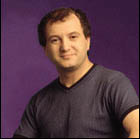Are you a journalist? Please sign up here for our press releases
Subscribe to our monthly newsletter:

Stars are born when gas clouds found in interstellar space shrink and collapse into themselves as a result of their own gravity. If this process passes a certain threshold, nuclear fusion begins within the cloud, causing the conversion of matter into energy and the emission of radiation we like to call "sun rays." Interstellar gas clouds are therefore a star's "maternity ward." Prof. Daniel Zajfman of the Weizmann Institute's Particle Physics Department seeks to better understand the complex molecular interactions occurring within them.
Since an interstellar gas cloud cannot be squeezed into a laboratory, Zajfman began analyzing reactions in a simulated environment provided by "ion storage rings" _ large and expensive installations that are found in no more than three or four research institutes throughout the world. To increase the efficiency of his research, he developed a relatively modest ion trap, which can perform the majority of the experiments thus far undertaken in the expensive rings. Other scientists in various institutions through-out the world have already begun to follow in Zajfman's footsteps by building similar ion traps.
His current research efforts involve the launching of individual electrons, which sequentially collide with molecules under examination, "awakening" them. The questions in this developing research field are as yet more numerous than the answers, but scientists hope that future insights obtained will help us to understand the underlying structure of matter and the creation of stars, as well as to develop more efficient industrial processes.
Prof. Daniel Zajfman Born - Brussels, Belgium Ph.D. - Technion, Haifa Postdoctoral research - Argonne National Laboratory, Illinois Weizmann Institute of Science - Since 1991